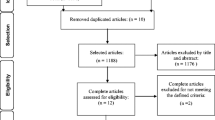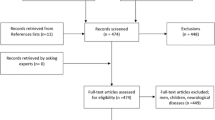Abstract
The objective of this study is to evaluate the effectiveness of existing physiotherapy modalities for the treatment of urge urinary incontinence (UUI). A systematic review was performed for primary studies of physiotherapy techniques for UUI published in English between 1996 and August 2010 in major electronic databases. Only randomized clinical trials that reported outcomes separately for women with UUI were included. Outcomes assessed were reduction in UUI, urinary frequency, and nocturia. Data from 13 full-text trials including the modalities of pelvic floor muscles exercises with or without biofeedback, vaginal electrical stimulation, magnetic stimulation, and vaginal cones were analyzed. The methodologic quality of these trials was fair. Significant improvement in UUI was reported for all physiotherapy techniques except vaginal cone therapy. There are insufficient data to determine if pelvic physiotherapy improves urinary frequency or nocturia. Evidence suggests that physiotherapy techniques may be beneficial for the treatment of UUI.

Similar content being viewed by others
References
Haylen BT, de Ridder D, Freeman RM, Swift SE, Berghmans B, Lee J et al (2010) An International Urogynecological Association (IUGA)/International Continence Society (ICS) joint report on the terminology for female pelvic floor dysfunction. Int Urogynecol J Pelvic Floor Dysfunct 21:5–26
Stewart WF, Van Rooyen JB, Cundiff GW, Abrams P, Herzog AR, Corey R et al (2003) Prevalence and burden of overactive bladder in the United States. World J Urol 20:327–336
Coyne KS, Sexton CC, Thompson CL, Milsom I, Irwin D, Kopp ZS et al (2009) The prevalence of lower urinary tract symptoms (LUTS) in the USA, the UK and Sweden: results from the Epidemiology of LUTS (EpiLUTS) study. BJU Int 104:352–360
Irwin DE, Milsom I, Hunskaar S, Reilly K, Kopp Z, Herschorn S et al (2006) Population-based survey of urinary incontinence, overactive bladder, and other lower urinary tract symptoms in five countries: results of the EPIC study. Eur Urol 50:1306–1314, discussion 1314–5
Dumoulin C, Hay-Smith J (2010) Pelvic floor muscle training versus no treatment, or inactive control treatments, for urinary incontinence in women. Cochrane Database Syst Rev (1):CD005654
Gamble TL, Du H, Sand PK, Botros SM, Rurak M, Goldberg RP (2010) Urge incontinence: estimating environmental and obstetrical risk factors using an identical twin study. Int Urogynecol J Pelvic Floor Dysfunct 21:939–946
Andersson KE, Arner A (2004) Urinary bladder contraction and relaxation: physiology and pathophysiology. Physiol Rev 84:935–986
Andersson KE, Wein AJ (2004) Pharmacology of the lower urinary tract: basis for current and future treatments of urinary incontinence. Pharmacol Rev 56:581–631
Leng WW, Chancellor MB (2005) How sacral nerve stimulation neuromodulation works. Urol Clin N Am 32:11–18
Saks EK, Arya LA (2009) Pharmacologic management of urinary incontinence, voiding dysfunction, and overactive bladder. Obstet Gynecol Clin North Am 36:493–507
Fowler CJ, Griffiths D, de Groat WC (2008) The neural control of micturition. Nat Rev Neurosci 9:453–466
Weiss JM (2001) Pelvic floor myofascial trigger points: manual therapy for interstitial cystitis and the urgency-frequency syndrome. J Urol 166:2226–2231
Hains G, Hains F, Descarreaux M, Bussieres A (2007) Urinary incontinence in women treated by ischemic compression over the bladder area: a pilot study. J Chiropr Med 6:132–140
Eisenstein SM, Engelbrecht DJ, el Masry WS (1994) Low back pain and urinary incontinence. A hypothetical relationship. Spine (Phila Pa 1976) 19:1148–1152
Chai TC, Steers WD (1997) Neurophysiology of micturition and continence in women. Int Urogynecol J Pelvic Floor Dysfunct 8:85–97
de Groat WC (1997) A neurologic basis for the overactive bladder. Urology 50:36–52, discussion 53–6
Birder L, de Groat W, Mills I, Morrison J, Thor K, Drake M (2010) Neural control of the lower urinary tract: peripheral and spinal mechanisms. Neurourol Urodyn 29:128–139
de Groat WC (2006) Integrative control of the lower urinary tract: preclinical perspective. Br J Pharmacol 147(Suppl 2):S25–S40
Schmidt RA, Jonas U, Oleson KA, Janknegt RA, Hassouna MM, Siegel SW et al (1999) Sacral nerve stimulation for treatment of refractory urinary urge incontinence. Sacral Nerve Stimulation Study Group. J Urol 162:352–357
Schmidt RA, Tanagho EA (1981) Urethral syndrome or urinary tract infection? Urology 18:424–427
Raz S, Smith RB (1976) External sphincter spasticity syndrome in female patients. J Urol 115:443–446
Kaplan WE, Firlit CF, Schoenberg HW (1980) The female urethral syndrome: external sphincter spasm as etiology. J Urol 124:48–49
Shafik A, Shafik IA (2003) Overactive bladder inhibition in response to pelvic floor muscle exercises. World J Urol 20:374–377
Ashton-Miller JA, Howard D, DeLancey JO (2001) The functional anatomy of the female pelvic floor and stress continence control system. Scand J Urol Nephrol Suppl (207):1–7, discussion 106–25
Gunnarsson M, Teleman P, Mattiasson A, Lidfeldt J, Nerbrand C, Samsioe G (2002) Effects of pelvic floor exercises in middle aged women with a history of naive urinary incontinence: a population based study. Eur Urol 41:556–561
Abrams P, Cardozo L, Fall M, Griffiths D, Rosier P, Ulmsten U et al (2003) The standardisation of terminology in lower urinary tract function: report from the standardisation sub-committee of the International Continence Society. Urology 61:37–49
Junemann KP, Schmidt RA, Melchior H, Tanagho EA (1987) Neuroanatomy and clinical significance of the external urethral sphincter. Urol Int 42:132–136
Hay-Smith EJ, Dumoulin C (2006) Pelvic floor muscle training versus no treatment, or inactive control treatments, for urinary incontinence in women. Cochrane Database Syst Rev (1):CD005654
Aslan E, Komurcu N, Beji NK, Yalcin O (2008) Bladder training and Kegel exercises for women with urinary complaints living in a rest home. Gerontology 54:224–231
Nygaard IE, Kreder KJ, Lepic MM, Fountain KA, Rhomberg AT (1996) Efficacy of pelvic floor muscle exercises in women with stress, urge, and mixed urinary incontinence. Am J Obstet Gynecol 174:120–125
Bo K, Berghmans LC (2000) Nonpharmacologic treatments for overactive bladder-pelvic floor exercises. Urology 55:7–11, discussion 14–6
Berghmans LC, Hendriks HJ, De Bie RA, van Waalwijk van Doorn ES, Bo K, van Kerrebroeck PE (2000) Conservative treatment of urge urinary incontinence in women: a systematic review of randomized clinical trials. BJU Int 85:254–263
Alhasso AA, McKinlay J, Patrick K, Stewart L (2006) Anticholinergic drugs versus non-drug active therapies for overactive bladder syndrome in adults. Cochrane Database Syst Rev (4):CD003193
Wang AC, Wang YY, Chen MC (2004) Single-blind, randomized trial of pelvic floor muscle training, biofeedback-assisted pelvic floor muscle training, and electrical stimulation in the management of overactive bladder. Urology 63:61–66
Williams KS, Assassa RP, Gillies CL, Abrams KR, Turner DA, Shaw C et al (2006) A randomized controlled trial of the effectiveness of pelvic floor therapies for urodynamic stress and mixed incontinence. BJU Int 98:1043–1050
Wyman JF, Fantl JA, McClish DK, Bump RC (1998) Comparative efficacy of behavioral interventions in the management of female urinary incontinence. Continence Program for Women Research Group. Am J Obstet Gynecol 179:999–1007
Burgio KL, Goode PS, Locher JL, Umlauf MG, Roth DL, Richter HE et al (2002) Behavioral training with and without biofeedback in the treatment of urge incontinence in older women: a randomized controlled trial. JAMA 288:2293–2299
Barroso JC, Ramos JG, Martins-Costa S, Sanches PR, Muller AF (2004) Transvaginal electrical stimulation in the treatment of urinary incontinence. BJU Int 93:319–323
Brubaker L, Benson JT, Bent A, Clark A, Shott S (1997) Transvaginal electrical stimulation for female urinary incontinence. Am J Obstet Gynecol 177:536–540
Amaro JL, Gameiro MO, Kawano PR, Padovani CR (2006) Intravaginal electrical stimulation: a randomized, double-blind study on the treatment of mixed urinary incontinence. Acta Obstet Gynecol Scand 85:619–622
Siegel SW, Richardson DA, Miller KL, Karram MM, Blackwood NB, Sand PK et al (1997) Pelvic floor electrical stimulation for the treatment of urge and mixed urinary incontinence in women. Urology 50:934–940
But I, Faganelj M, Sostaric A (2005) Functional magnetic stimulation for mixed urinary incontinence. J Urol 173:1644–1646
Fujishiro T, Takahashi S, Enomoto H, Ugawa Y, Ueno S, Kitamura T (2002) Magnetic stimulation of the sacral roots for the treatment of urinary frequency and urge incontinence: an investigational study and placebo controlled trial. J Urol 168:1036–1039
Morris AR, O’Sullivan R, Dunkley P, Moore KH (2007) Extracorporeal magnetic stimulation is of limited clinical benefit to women with idiopathic detrusor overactivity: a randomized sham controlled trial. Eur Urol 52:876–881
Vasavada SP, Goldman HB, Rackley RR (2007) Neuromodulation techniques: a comparison of available and new therapies. Curr Urol Rep 8:455–460
Moseley AM, Herbert RD, Maher CG, Sherrington C, Elkins MR (2011) Reported quality of randomized controlled trials of physiotherapy interventions has improved over time. J Clin Epidemiol 64:594–601
Acknowledgments
The authors thank Nicole L. Dugan, DPT, CLT of Good Shepherd Penn Partners, Penn Therapy and Fitness, Philadelphia, PA for her physical therapy expertise and Megan O. Schimpf, MD of University of Pennsylvania Department of Obstetrics and Gynecology, Philadelphia, PA for her editorial expertise.
Conflicts of interest
None.
Disclaimers
Joy A. Greer, MD, LCDR, MC, USN—LCDR Greer is a military service member. This work was prepared as part of her official duties. Title 17, USC, paragraph 105 provides that “Copyright protection under this title is not available for any work of the United States Government.” Title 17, USC, paragraph 101 defines a U.S. Government work as a work prepared by a military service member or employee of the U.S. Government as part of that person’s official duties. The views expressed in this article are those of the authors and do not necessarily reflect the official policy or position of the Department of the Navy, Department of Defense, nor the U.S. Government.
Author information
Authors and Affiliations
Corresponding author
Rights and permissions
About this article
Cite this article
Greer, J.A., Smith, A.L. & Arya, L.A. Pelvic floor muscle training for urgency urinary incontinence in women: a systematic review. Int Urogynecol J 23, 687–697 (2012). https://doi.org/10.1007/s00192-011-1651-5
Received:
Accepted:
Published:
Issue Date:
DOI: https://doi.org/10.1007/s00192-011-1651-5




